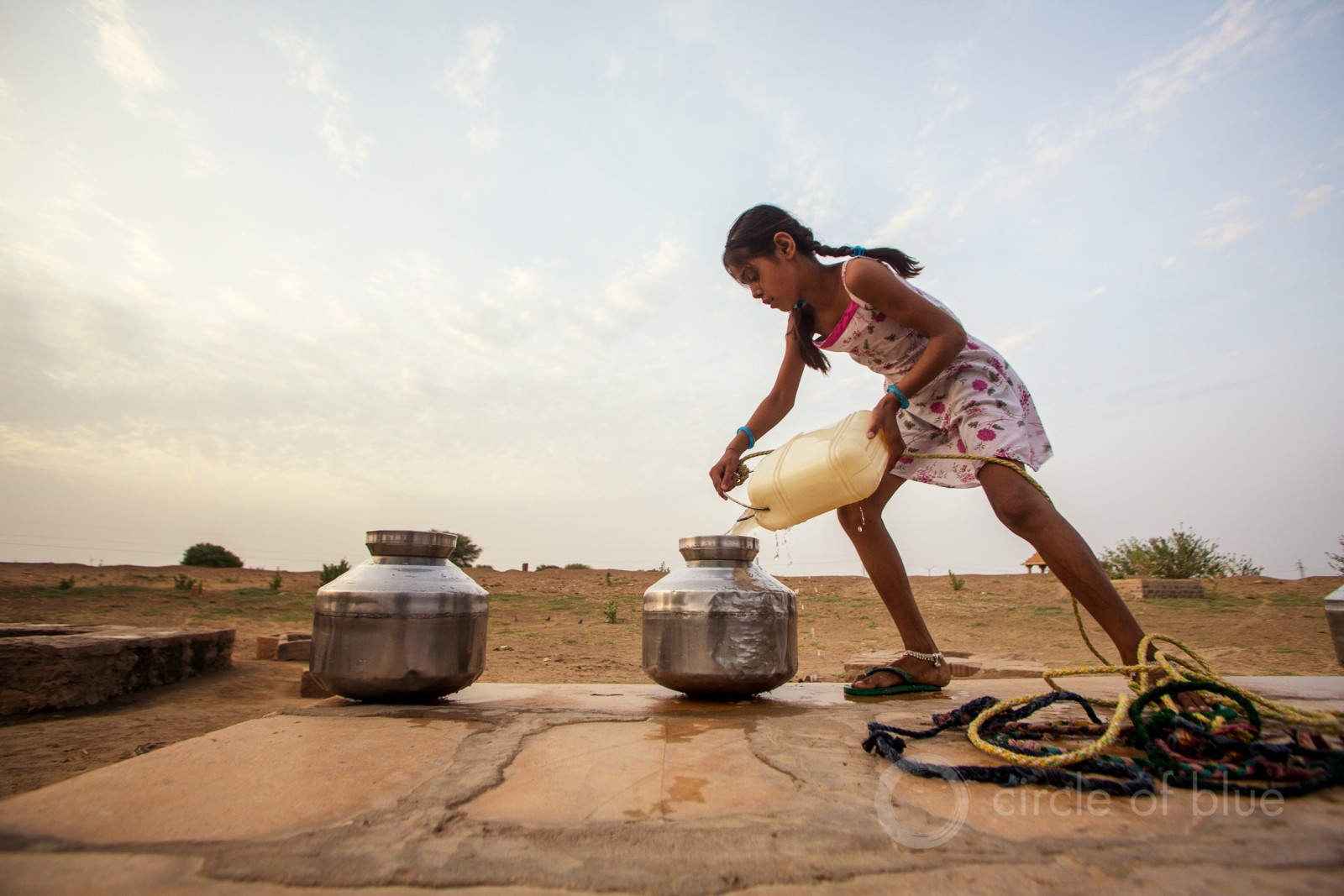Land degradation and climate change are posing major threats to India’s economy and farmers.

Rajasthan, India. Photo © J. Carl Ganter/Circle of Blue
By Rohit Inani, for Al Jazeera
This story originally appeared in Al Jazeera. It is republished here as part of Circle of Blue‘s partnership with Covering Climate Now, a global collaboration of more than 250 news outlets to strengthen coverage of the climate story.
Gurugram, India – A highway leading from Gurugram – a technology and business hub south of the Indian capital New Delhi – cuts through swaths of empty plots, land that once contained fertile green fields, but which is now mostly barren and dotted with cranes towering over unfinished buildings.
A real estate boom fuelled by India’s rapid economic growth in recent years has transformed thousands of hectares of arable land in the region into plots for glass-and-steel high-rises.
Scientists describe such land as being degraded. The United Nations’ Food and Agriculture Organization (FAO) defines land degradation as “the temporary or permanent lowering of the productive capacity of land”.
In other words, it becomes increasingly difficult to grow crops on such land. And if it is not stopped, the process can lead to desertification.
The UN estimates that more than 3.2 billion people around the world are at risk from the effects of land degradation, many of whom live in the world’s poorest regions. And, according to an Indian government-backed study, land degradation led to a roughly 2.5 percent loss of the country’s economic output between 2014 and 2015.
This is a problem India can ill afford. Its economy is slowing, unemployment is near record highs and more than 40 percent of its workforce is engaged in agriculture. The government has promised to tackle land degradation, but critics say its proposed solutions do not go far enough.
Land degradation is a phenomenon that Pappu, a labourer who brings his cattle to graze on what vegetation remains on the outskirts of Gurugram, knows all too well. He first came here several years ago from the neighbouring state of Rajasthan, forced to move when yields on his farm fell because of the rising salinity of the water supply.
“Everything was fine and our yields were enough to sustain the family until this happened,” Pappu, who is 50 and goes by one name, told Al Jazeera. He said most of the farmers in his village in Rajasthan gave up agriculture and migrated to Gurugram where they took up jobs as security guards, construction workers and day labourers.
“Our land [in Rajasthan] is of no use any more. We could never have sustained our families if we didn’t come to the city,” Pappu said.
But the prognosis for the health of the land around Gurugram doesn’t appear to be too rosy either.
According to government data, nearly 30 percent of the land in India, or about 97 million hectares, is degraded. That is an area about the size of northern Europe.
Causes and effects
A major cause of land degradation is human activity. The World Health Organization (WHO) cites “increasing and combined pressures of agricultural and livestock production (over-cultivation, overgrazing, forest conversion), urbanization [and] deforestation” as leading causes. Construction activity and the overuse of pesticides and chemical fertilisers for farming are also seen as contributors.
Following famines in the late 1940s, fertilisers and pesticides helped India transform its agriculture sector by the early 1960s, a development that has come to be known as the Green Revolution. Ironically, the same chemicals have also had damaging effects on the soil.
“We have reached a state where fertilisers have been used so much that it has led to a degradation of land quality,” Saudamini Das, an economist at the Institute of Economic Growth in New Delhi, told Al Jazeera.
But the WHO says “extreme weather events such as droughts and coastal surges which salinate land” also contribute to the loss of land productivity. This year, India witnessed the second-driest pre-monsoon season in more than 60 years, leading to droughts in its northwestern and southern states.
This is where causes and effects start to drive one another, making land degradation an intractable problem the world over.
“The socioeconomic effects of climate change … exacerbate land degradation,” Ibrahim Thiaw, executive secretary of the UN Convention to Combat Desertification (UNCCD), which is holding its 14th Conference of Parties (COP14) in New Delhi, told Al Jazeera.
The loss of land productivity can, in turn, contribute to climate change as the loss of plants makes it harder to draw excess carbon dioxide from the air.
“Land degradation is a driver of climate change through emission of greenhouse gases and reduced rates of carbon uptake,” the Intergovernmental Panel on Climate Change (IPCC) said in a report published last month.
Sunita Narain, director of the Centre for Science and Environment (CSE) in New Delhi, said: “Land degradation and desertification in an age of climate change is a different animal, unlike in earlier times.”
“In India, [this trend] is a cause of land and water mismanagement, and it is now exacerbated by climate change events,” Narain told Al Jazeera.
Land degradation can also have more direct effects on people’s lives.
The UN FAO says land degradation can lead to a drop in people’s incomes, result in dwindling food supplies, meaning more effort, time, and money are needed to achieve a sustainable level of crop yields.
Low farm output, owing to low productivity, can drive food prices higher, squeezing the livelihoods of people already on the margins.
Ultimately, many people in rural areas, like Pappu, are forced to leave their homes in search of jobs in cities, adding to the pressure on stretched urban resources.
In other cases, some farmers decide the only way out is to take their own lives. In the two decades leading up to 2015, more than 321,000 farmers committed suicide, according to national crime records, though debts and falling crop prices are likely to have added to the psychological stress of low farm yields.
The effects of land degradation on entire economies can also be significant.
India’s economy is growing at a six-year low of about 5 percent, and experts are warning of a gathering rural slowdown with falling wage growth and record-high unemployment rates. The fact that close to half of India’s workforce is engaged in agriculture makes the country’s economy particularly vulnerable to the effects of climate change and land degradation.
“Whenever you create stress on land, the shockwave affects millions of people. And here you see a very clear correlation. [For instance], years of drought lead to years of economic downturn. And this downturn is sudden,” the UNCCD’s Thiaw said.
“India’s growing middle class would need increasing resources going forward and [this] would make more demand on land to deliver energy, water and fibre. India should start restoring its land or else it would affect its economy in the long run,” he added.
Action against degradation
So what can governments and individuals do to restore their lands to health?
Indian Prime Minister Narendra Modi said his government would commit to restoring 5 million hectares of degraded land by 2030, in addition to a previous commitment of 21 million hectares.
But the UN says that would not be enough. It says India needs to restore at least 30 million hectares in the next 10 years to reverse land degradation by 2030.
At the COP14 summit in New Delhi, the UN pointed out that the funds made available by governments to restore land globally are insufficient and called for more investments from the private sector.
A much bigger challenge is likely to be getting governments to agree to joint action.
US President Donald Trump’s decision in 2017 to withdraw from the Paris climate agreement has helped divide opinion about climate change and its effects, analysts say.
“There are powerful voices shaking multilateralism but [I’d say] that there is no alternative to it. The planet is burning, our food supplies are being jeopardised. You ask yourself that, where are we going? We cannot continue to exploit our planet for the rest of any president’s term or political party,” said Thiaw.
The Centre for Science and Environment’s Narain said that instead of asking for more private investments to restore lands, the global community should work towards giving greater land rights to the tribal communities who own these lands, and called upon the UN to work on a broader climate agenda by including them, who she says have suffered immensely from climate change.
“As far as money and finances are concerned, I think the world is extremely selfish,” Narain said. “If the world cannot accept [and identify] with the victims of climate change today, then I think we are dealing with a global leadership that is defunct.”
But the choices we all make every day as consumers could also have a major impact on those suffering from degraded lands.
The IPCC in its report last month, titled Climate Change and Land, said better land management and the consumption of healthier diets can help address climate change and its effects.
“We need to look at how we can reduce emissions from land and how we can use it to cause carbon removal,” Joanna House, one of the report’s lead authors told Al Jazeera.
The report stresses the importance of reducing food waste, eating less meat and more grains, vegetables and nuts.
“Underlying this report is the fact that a relatively small number of giant meat, agribusiness and biofuel companies are responsible for the bulk of deforestation and other climate pollution in the agriculture sector,” said Glenn Hurowitz, CEO of global campaign group Mighty Earth.




